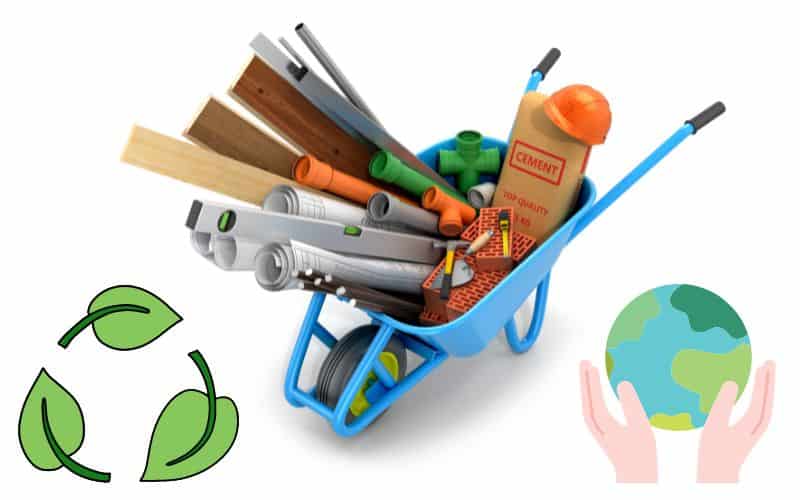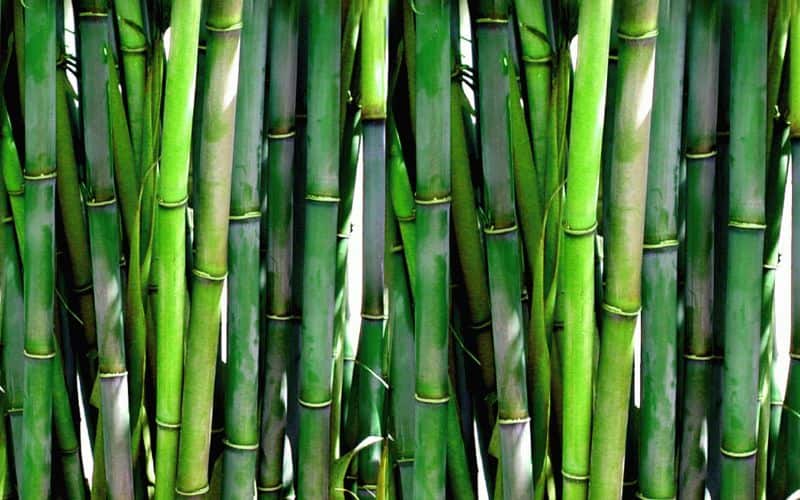What Are Sustainable Materials: How To Know for Sure

Builders and architects understand the importance of using sustainable materials better than ever these days.
In addition, many clients require sustainability to be designed into their building projects, driving innovation and more sustainable processes along the construction industry supply chain.
However, there remains confusion in some quarters about what sustainable materials are, why we should be using them, and how to know for sure that any given material is truly sustainable.
Sustainable building materials use raw materials that can be replenished, take little energy to make, and release minimal carbon dioxide into the atmosphere. In addition, they are ethically produced, contain no harmful chemicals, and can be reused or recycled at the end of their service life.
The benefits of using sustainable materials for construction are manifold for both builders and clients.
We’ll cover the main benefits in this article, including the broader benefits for society and the global environment.
We’ll also explain how you can identify sustainable materials based on scientific studies, certification schemes, and asking the right questions.
By the end of this article, you should be confident in identifying sustainable materials so you can choose the best ones for your projects.
Let’s get into it.
What Are Sustainable Materials?

All sorts of buzzwords are used about the environment these days. You can’t move without some overenthusiastic marketer telling you that their product is “completely renewable,” the “greenest in its class,” or “has no environmental impact.”
There is a lot of overlap between these terms, some of which are pretty vague. I’ve discussed this in another article on the blog – Green vs. Sustainable vs. Renewable Materials: We Compare.
The Origins Of Sustainability

There is an official definition of what sustainable development means, which came from the Brundtland Report of 1987. It is as follows:
“development that meets the needs of the present without compromising the ability of future generations to meet their own needs.”
So, to be considered sustainable, any building materials must be sourced in accordance with this goal.
The great and the good have iterated and improved that statement over the last forty years. In 2015, the culmination of all that work was published and adopted by the UN General Assembly in its 17 Sustainable Development Goals.
You can read all about the goals here, but they can be summarized strategically as promoting social and economic development while protecting and improving the environment.
Tools For Measuring Sustainability
As organizations got behind the principles underpinning sustainability, they needed a way of measuring it to demonstrate how sustainable their actions, products, and services were.
The Integrated Reporting Framework

The corporate world has always been good at demonstrating financial value and producing financial reports for investors and other interested parties.
But there needed to be an agreed-upon way of reporting the overall environmental impact and the social and environmental value created by an organization. The Integrated Reporting Framework (the <IR> Framework) was developed to fill this gap.
The <IR> Framework aims to understand the relationships and resources an organization leverages to create, protect, or abrade value over the planning period.
A key concept the framework uses to achieve this is the six capitals, representing stocks and flows of value that the organization influences in its operations.
The Six Capitals

The concept of the 6 Capitals has been developed as part of the Integrated Reporting Framework to help describe how an organization creates value over time.
The <IR> Framework and the capitals are used by many businesses to help describe the wider benefits their activities bring to society. These tools are one way that the sustainability of a company, its products, and its services can be demonstrated.
Many boardrooms have seen the need to demonstrate the value they provide, not just in terms of money (financial capital) but also in terms of the environment (natural capital) and society (social capital).
The six capitals are as follows.
- Natural capital: The environment and natural materials, including air, water, land, minerals, and forests.
- Manufactured capital: The equipment, buildings, and machinery used to create products and provide services.
- Social capital: Relationships between people in society, between companies and customers, suppliers, governments, and regulators.
- Human capital: The people working for an organization, their health and wellbeing, their brainpower, and enthusiasm.
- Intellectual capital: An organization’s knowledge, including intellectual property, research and development, and the collective understanding of its workforce.
- Financial capital: The organization’s financial resources, shares, bonds, and petty cash, which it uses to buy raw materials, expertise, and other essential items to operate successfully.
A sustainably-run organization creates value across all six capitals, and to be the most sustainable it can be, it must maximize the value of each of these capitals through its operations.
Definition Of Sustainable Materials

The <IR> Framework and the six capitals allow us to define sustainable materials in the following way.
Sustainable materials are produced so that value is maximized across all six capitals. The company is profitable (maximizing financial capital), the environment is protected (natural capital), the communities it operates in are successful and thriving (human and social capital), and so on.
The diagram below shows this intersection between the natural environment, society, and the economy. All three circles in the Venn diagram must be maximized for sustainability to be achieved.

We can all get behind that, but what does it mean in practice? Let’s look at an example of a sustainable building material to illustrate.
What Is An Example of a Sustainable Material?
There are many good examples of sustainable building materials. We’ve compiled a list of 23 of the top sustainable building materials if you’re interested in reading about them.
For now, though, let’s pick one of the most sustainable materials and look at how it maximizes value across the six capitals representing the environment, society, and the economy.
We’re going to look at bamboo. Then, to help explain why bamboo is considered a sustainable material, we’ll compare it to a much less sustainable material, steel.
I’ve chosen these materials because they are both used for scaffolding on construction projects. In Southeast Asia, bamboo is common, whereas scaffolding tends to be of the steel tubing variety in the US and Europe.
This allows for an almost direct comparison of the two materials and is easy to visualize. But which is the most environmentally friendly alternative?
Bamboo

Bamboo has properties that allow it to be used in a wide range of applications in the construction industry.
Some of the factors that make bamboo a sustainable material are as follows.
- Bamboo is renewable: It is naturally occurring and grows remarkably quickly (almost 3 feet per day) and regenerates fast.
- Bamboo is lightweight: This makes it easy to handle during construction and uses less energy in transportation.
- Bamboo is strong: It has a tensile strength in the range of 140-280N/mm2, which is more than enough to build scaffolding.
Steel

Some of the factors that make steel a less sustainable alternative include the following.
- Steel has high embodied energy: The process of producing steel is highly energy intensive, starting with mining iron ore and coal, followed by the process itself, which uses large amounts of energy and emits a lot of carbon dioxide.
- Steel is not renewable: The production of iron and the manufacture of steel rely on non-renewable raw materials (mainly iron ore and coal) that are mined from the earth and are never replenished on human timescales.
- Steel is heavy: The weight of steel means transportation costs and fuel usage are very high, resulting in higher greenhouse gas emissions.
Using the Six Capitals to Compare the Sustainability of Bamboo and Steel
Comparing steel and bamboo using the six capitals is somewhat subjective and can be done using qualitative or quantitative data and even educated judgments.
A fictitious comparison of these two materials is set out in the following table (for illustrative purposes only).

Now, this comparison is for illustrative purposes only because a full sustainability assessment is well beyond the scope of this article.
Besides, doing the assessment properly would require more information about where the bamboo is harvested, how far it is transported, how sustainably managed the bamboo forest is, and so on.
Likewise for the steel. Where is the ore mined, what extraction process is used to make the iron, and how is it transformed into steel? How far is it transported, and will it be recycled at the end of its service life?
All these questions need answers before an accurate assessment can be done.
So you can see that things can get very complicated. How, therefore, are you supposed to know which products to use?
This is where certification schemes come into play.
How to Know for Sure if a Material is Sustainable

You could do your own sustainability assessment for each building material you use and your project overall.
Some construction companies do precisely this, reporting the value they add to each of the capitals across their operations using the Integrated Reporting Framework.
However, not everyone has the time, resources, or inclination to do such a thorough job.
It’s possible to make some judgments simply by asking your suppliers the right questions. But how do you verify their claims?
One (mostly) reliable solution is to buy only from suppliers certified under a sustainability certification scheme.
There are lots of these schemes, all specializing in a different niche and catering to different audiences, but there are overlaps, and it can take time to know which one to use.
Certification Schemes
Certification schemes can help you select sustainable products and materials with a lower carbon footprint that use fewer fossil fuels in their manufacturing process and avoid harsh chemicals.
These schemes often go beyond such basic criteria and provide a thorough assessment of overall sustainability.
Let’s look at two of the most commonly encountered.
LEED

LEED stands for Leadership in Energy and Environmental Design and is a certification tool developed by the US Green Building Council.
It is used in 167 countries worldwide. The USGBC hopes to use it and other tools, along with engagement with communities and industry, to transform the built environment and make it more sustainable for everyone.
LEED-certified buildings can help to improve efficiency and reduce energy consumption. They also promote using sustainable materials, leading to reduced carbon dioxide emissions, lower costs, improved human health, and better communities.
LEED drives these improvements by awarding certifications based on criteria that demonstrate improvements in the impacts products and materials have over their entire life cycle. This encourages the recycling of waste material, reclamation, and the minimization of the use of raw material.
Some of the factors LEED uses to identify sustainable materials include the following.
- Locally produced (half the raw materials are sourced within 100 miles).
- 25% reclaimed or refurbished materials.
- Concrete that contains a minimum of 30% fly ash instead of cement and more than half recycled content OR 90% recycled materials or reclaimed aggregate.
- Wood products are certified by the Forest Stewardship Council (FSC).
You can see LEED’s guide to “environmentally preferable products” on its website. It’s a valuable reference for informing procurement decisions for sustainable building materials.
Forest Stewardship Council (FSC)

The Forest Stewardship Council is an international non-profit organization that helps to protect forests by encouraging responsible forestry through its certification schemes.
The certifications support a wide range of benefits that a healthy forest ecosystem can provide and good practices, including the following.
- Responsibly managed forests.
- Responsible sourcing of wood.
- Zero deforestation.
- Preserving and increasing forest value in terms of conservation.
- Restoring forests more quickly.
- Ensuring fair wages for forestry workers.
- Safeguarding good working conditions for forestry workers.
- Preserving biodiversity.
- Promoting community rights.
FSC certifies the entire chain of custody from forest to store, so you can be confident that wood products labeled with the FSC logo are genuinely sustainable.
There are other certification schemes that can help you reach good sustainable decisions about which materials to use in your projects.
It’s always worth doing your homework to ensure they meet your requirements because they all vary in terms of what they cover and how stringent they are.
Conclusion
Sustainable materials are produced in a way that minimizes the impact on (or improves) the environment while benefiting society and the economy.
Sustainable materials minimize their use of natural resources and often contain a high percentage of reclaimed or recycled content, only requiring a little energy in their manufacture.
They should be produced locally and in an ethical manner that helps communities to thrive, providing jobs and opportunities.
There are certification schemes that independently assess the sustainability of products, and these are very helpful for selecting materials to use.
The only way to know for sure whether materials are sustainable is to follow their journey from the cradle to the grave and satisfy yourself that their whole life impact meets the sustainability criteria described in this article.
Not many of us can afford that, so sourcing materials from certified suppliers is a good way for us to make a more environmentally friendly and sustainable choice.







